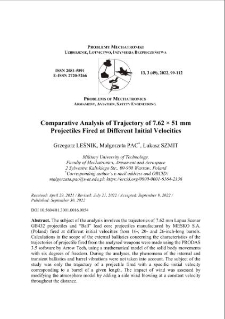Nasza Biblioteka Cyfrowa udostępnia 1 868 obiektów cyfrowych
Obiekt
Tytuł: Comparative Analysis of Trajectory of 7.62 × 51 mm Projectiles Fired at Different Initial Velocities ; Comparative Analysis of Trajectory of 7.62 × 51 mm Projectiles Fired at Different Initial Velocities
Tytuł odmienny:
Analiza porównawcza torów pocisków 7,62 × 51 mm wystrzelonych z różnymi prędkościami początkowymi ; Analiza porównawcza torów pocisków 7,62 × 51 mm wystrzelonych z różnymi prędkościami początkowymi
Współtwórca:
Małgorzata PAC, Łukasz SZMIT ; Małgorzata PAC, Łukasz SZMIT
Abstrakt:
The subject of the analysis involves the trajectories of 7.62 mm Lapua Scenar GB432 projectiles and “Ball” lead core projectiles manufactured by MESKO S.A. (Poland) fired at different initial velocities from 16-, 20- and 26-inch-long barrels. Calculations in the scope of the external ballistics concerning the characteristics of the trajectories of projectile fired from the analysed weapons were made using the PRODAS 3.5 software by Arrow Tech, using a mathematical model of the solid body movements with six degrees of freedom. During the analyses, the phenomena of the internal and transient ballistics and barrel vibrations were not taken into account. The subject of the study was only the trajectory of a projectile fired with a specific initial velocity corresponding to a barrel of a given length. The impact of wind was assessed by modifying the atmosphere model by adding a side wind blowing at a constant velocity throughout the distance. The results allowed the analysis of the effect of the barrel length and the associated initial velocity of the projectile on the nature of the projectile trajectory, especially the obtained overheight path and projectile range. The impact of the side wind on different types of projectiles was also assessed. When shooting precision rifles, it is better to use rounds with heavy projectiles, optimized for long-distance shooting. Lightweight-projectile rounds can be successfully used in the semi-automatic rifles used for support at the lowest levels, where more manoeuvrability (including barrels with a length not exceeding 20 inches) and higher fire rate is required, and, at the same, where shooting at distances exceeding 500 m is not necessary. Lightweight-projectile rounds can also be successfully used for marksmanship training at distances below 500 m, where the differences between the trajectories of different projectiles are the least.
;
The subject of the analysis involves the trajectories of 7.62 mm Lapua Scenar GB432 projectiles and “Ball” lead core projectiles manufactured by MESKO S.A. (Poland) fired at different initial velocities from 16-, 20- and 26-inch-long barrels. Calculations in the scope of the external ballistics concerning the characteristics of the trajectories of projectile fired from the analysed weapons were made using the PRODAS 3.5 software by Arrow Tech, using a mathematical model of the solid body movements with six degrees of freedom. During the analyses, the phenomena of the internal and transient ballistics and barrel vibrations were not taken into account. The subject of the study was only the trajectory of a projectile fired with a specific initial velocity corresponding to a barrel of a given length. The impact of wind was assessed by modifying the atmosphere model by adding a side wind blowing at a constant velocity throughout the distance. The results allowed the analysis of the effect of the barrel length and the associated initial velocity of the projectile on the nature of the projectile trajectory, especially the obtained overheight path and projectile range. The impact of the side wind on different types of projectiles was also assessed. When shooting precision rifles, it is better to use rounds with heavy projectiles, optimized for long-distance shooting. Lightweight-projectile rounds can be successfully used in the semi-automatic rifles used for support at the lowest levels, where more manoeuvrability (including barrels with a length not exceeding 20 inches) and higher fire rate is required, and, at the same, where shooting at distances exceeding 500 m is not necessary. Lightweight-projectile rounds can also be successfully used for marksmanship training at distances below 500 m, where the differences between the trajectories of different projectiles are the least.
Miejsce wydania:
Warszawa
;
Warszawa
Wydawca:
Wojskowa Akademia Techniczna ; Wojskowa Akademia Techniczna
Data utworzenia:
Data złożenia:
Data akceptacji:
Data wydania:
Rozmiar:
Identyfikator:
oai:ribes-88.man.poznan.pl:2649
Sygnatura:
DOI 10.5604/01.3001.0016.0054 ; DOI 10.5604/01.3001.0016.0054
ISSN elektroniczny:
ISSN drukowany:
Język:
Licencja:
kliknij tutaj, żeby przejść ; kliknij tutaj, żeby przejść
Właściciel praw:
Wojskowa Akademia Techniczna ; Wojskowa Akademia Techniczna
Strona początkowa:
Strona końcowa:
Tom:
Słowa kluczowe:
mechanics, ammunition, ballistics, small arms, rifle ; mechanics, ammunition, ballistics, small arms, rifle
Kolekcje, do których przypisany jest obiekt:
Data ostatniej modyfikacji:
13 paź 2025
Data dodania obiektu:
13 paź 2025
Liczba wyświetleń treści obiektu:
0
Wszystkie dostępne wersje tego obiektu:
https://ribes-88.man.poznan.pl/publication/2978
Wyświetl opis w formacie RDF:
Wyświetl opis w formacie OAI-PMH:
| Nazwa wydania | Data |
|---|---|
| Comparative Analysis of Trajectory of 7.62 × 51 mm Projectiles Fired at Different Initial Velocities | 13 paź 2025 |
Obiekty Podobne
Łukasz SZMIT Mirosław ZAHOR
Grzegorz LEŚNIK Józef GACEK
Grzegorz LEŚNIK Józef GACEK
Grzegorz LEŚNIK

